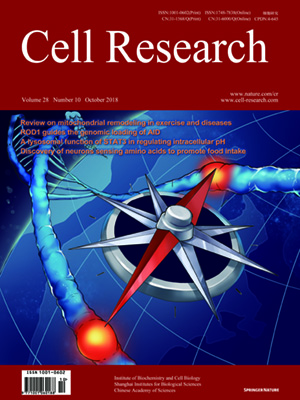
Volume 28, No 10, Oct 2018
ISSN: 1001-0602
EISSN: 1748-7838 2018
impact factor 17.848*
(Clarivate Analytics, 2019)
Volume 28 Issue 10, October 2018: 969-980
REVIEWS
Skeletal muscle mitochondrial remodeling in exercise and diseases
Zhenji Gan 1, Tingting Fu 1 , Daniel P. Kelly 2 and Rick B. Vega 3
1The State Key Laboratory of Pharmaceutical Biotechnology and MOE Key Laboratory of Model Animals for Disease Study, Department of Spine Surgery, Nanjing Drum Tower Hospital, The Affiliated Hospital of Nanjing University Medical School, Model Animal Research Center of Nanjing University, 210061 Nanjing, China; 2Cardiovascular Institute and Department of Medicine, Perelman School of Medicine, University of Pennsylvania, Philadelphia, PA 19104, USA and 3Translational Research Institute for Metabolism and Diabetes, Florida Hospital, Orlando, FL 32804, USA
Correspondence: Correspondence: Zhenji Gan (ganzj@nju.edu.cn) or Daniel P. Kelly (dankelly@pennmedicine.upenn.edu) or Rick B. Vega (richard.vega@flhosp.org)
Skeletal muscle fitness and plasticity is an important determinant of human health and disease. Mitochondria are essential for maintaining skeletal muscle energy homeostasis by adaptive re-programming to meet the demands imposed by a myriad of physiologic or pathophysiological stresses. Skeletal muscle mitochondrial dysfunction has been implicated in the pathogenesis of many diseases, including muscular dystrophy, atrophy, type 2 diabetes, and aging-related sarcopenia. Notably, exercise counteracts the effects of many chronic diseases on skeletal muscle mitochondrial function. Recent studies have revealed a finely tuned regulatory network that orchestrates skeletal muscle mitochondrial biogenesis and function in response to exercise and in disease states. In addition, increasing evidence suggests that mitochondria also serve to “communicate” with the nucleus and mediate adaptive genomic re-programming. Here we review the current state of knowledge relevant to the dynamic remodeling of skeletal muscle mitochondria in response to exercise and in disease states.
https://doi.org/10.1038/s41422-018-0078-7
FULL TEXT | PDF
Browse 1504


